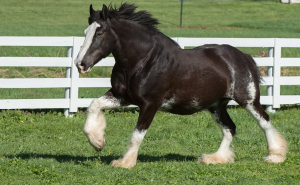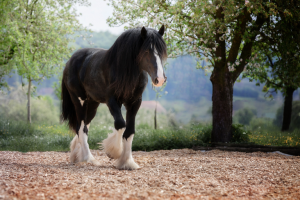Shire Horses: Excellent Guardians of English Heritage and Tradition.

Developed by esteemed horse breeders across Derbyshire, Staffordshire, Herefordshire, and Lincolnshire—collectively known as the ‘shires’—these magnificent draught horses embody strength, history, and enduring English heritage.
The inception of the Shire horse dates back to the dawn of animal husbandry, where English livestock farmers meticulously selected their largest stallions for breeding. Their ancestry goes back to the time of Henry VIII, who is most known for having passed legislation safeguarding the fabled “Great Horse,” a breed largely bred for combat. But with the invention of gunpowder, military strategies changed, and the need for large warhorses decreased, shifting their use to agriculture.

Image Credit: Bob Langrish
These powerful animals, whose size and strength made them ideal for labor-intensive farm work, became the preferred plow horses of British farmers. Originally a workhorse in the fields, the Shire saw a boom in popularity during World War I when it was used to tow artillery pieces. However, mechanization reduced their importance in the post-war era, pushing them to the sidelines while tractors took up their place in society.
Amidst dwindling numbers, a dedicated few, including English breweries, selectively bred conforming animals to preserve the Shire ‘type,’ ensuring the breed’s survival. The Shire Horse Society, previously known as the English Cart Horse Society, played a pivotal role in establishing standards, publishing stud books, and organizing the inaugural World Shire Horse Congress in 1996.
The rich history of the Shire horse encompasses its ties to land reclamation projects, where European breeds like Brabants and Friesians crossed the channel and interbred with England’s ‘Great Horses.’ Figures like Robert Bakewell and the famed ‘Packington Blind Horse’ contributed to the breed’s evolution, culminating in the recognition of Shire horses as champions in their respective counties by the middle 1700s.

Shire horses are easily identified by their black, bay, or grey coats, which are complemented by white facial markings and luxurious leg feathering. They are symbols of strength and elegance. Held in high regard for their enormous stature—averaging 16.2 to 18 hands—and sturdy physique, they have set world records for both size and height, with the fabled Mammoth (Sampson) reaching a height of almost 21.2 hands.
In order to protect and control the breeding of purebred Shire horses in Canada, the Canadian Shire Horse Association (CSHA) is now essential. With a focus on DNA verification for registration, the association upholds breed standards and encourages ethical breeding methods.
Despite their formidable stature, Shire horses possess gentle temperaments, making them ideal companions for riders of all ages. Renowned for their patience and reliability, they excel as school horses and exhibit a calm demeanor even in bustling environments.
Shires’ strength for pulling weight endears them to agricultural and logging operations, providing an environmentally-friendly alternative to machinery. Their adaptability and gentle disposition make them popular among children and riding enthusiasts, while their diet and health require specific care to maintain their well-being.

Similar: Meet gentle giant shire horse, the special horse breed




